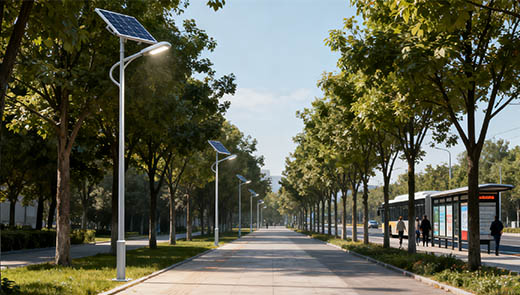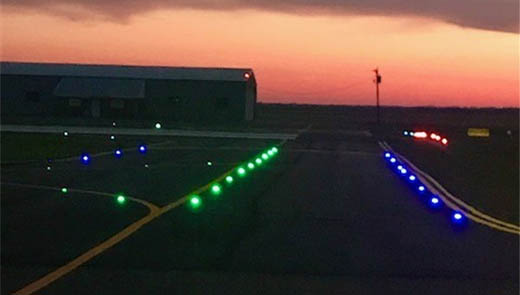Benefits of Using Solar Street Light in Rural Areas
In today's world, sustainable development has become a global consensus, and energy innovation is a key priority. Compared with the relatively well-developed energy supply system in cities, rural areas, especially remote villages, have long faced difficulties in energy access and utilization. Traditional backward energy methods are not only difficult to meet the needs of rural development, but also bring many negative effects. Solar street lights, with their unique advantages, are quietly bringing light to the change of energy and living patterns in rural areas, and their application value in rural areas is worth exploring.
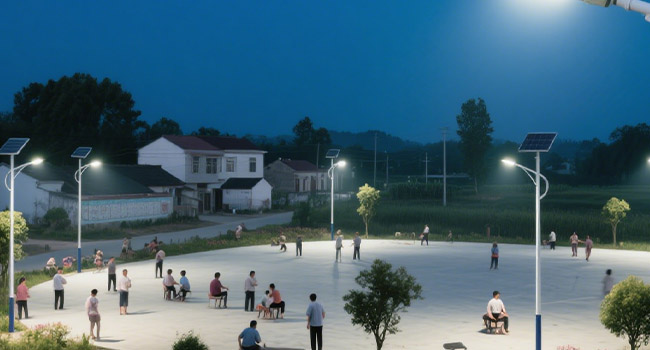
The Growing Need for Sustainable Energy in Rural Communities
In the context of the global energy transition, the growing need for sustainable energy in rural areas has been a major challenge, but power is scarce in remote areas, and many residents rely on traditional energy devices such as diesel generators and kerosene lights. These devices are not only costly - small diesel generators, for example, are a heavy burden on rural households in terms of hourly fuel costs - but also emit large quantities of pollutants, while kerosene lights cause respiratory illnesses in a large number of rural villages due to the smoke they produce. Traditional energy sources exacerbate energy poverty, hinder economic development and threaten public health. Therefore, there is an urgent need for sustainable energy programs in rural areas, and solar street lights with clean, renewable characteristics, to solve the problem of rural energy and lighting to bring new hope.
Core Advantages of Solar Street Lights
Solar led street lights rely entirely on solar power to convert clean, renewable energy into electricity for nighttime lighting. This method of energy acquisition not only meets the needs of nighttime activities in rural areas, but also significantly reduces the carbon footprint.
Compared with traditional street lights, solar street lights offer significant advantages in terms of component composition and performance:
|
Comparison Item |
Traditional Street Light |
Solar Street Light |
|
Energy Source |
Grid electricity |
Solar energy |
|
Main Components |
Regular bulbs, electric wires, etc. |
High-efficiency solar panels, 8-year lifespan lithium battery, efficient LEDs, smart controller |
|
Installation Method |
Requires complex wiring and professional team |
Compact and integrated design; easy for anyone to install without professional help |
|
Maintenance Cost |
Frequent maintenance due to wire aging, bulb replacement; high cost |
Long-lasting lithium battery; typically no need for replacement within 5 years; low maintenance cost |
|
Environmental Impact |
Consumes fossil fuels, emits carbon |
Zero carbon emissions, no harmful gas emissions |
Benefits of Solar Street Lights in Villages
Provide Security
In rural areas, the scarcity of electricity at night has long been a constraint on villagers' mobility. After nightfall, the darkness of the countryside not only makes travel full of unknown risks, but also provides a cover for theft, robbery and other crimes, threatening the lives and properties of villagers. The installation of solar street lights is like lighting up a “peace light” for the countryside at night. Bright street lights illuminate every countryside path, villagers do not need to worry about security issues even when traveling late at night, and are able to freely carry out night activities. At the same time, sufficient lighting makes criminals have no place to hide, effectively reducing the probability of all kinds of crimes, and creating a safe and stable living environment for rural areas.
Improve Health
Kerosene lights were once widely used in rural areas, but the frequent use of kerosene lights is quietly eroding the health of rural residents, especially women and children who stay at home for long periods of time. Kerosene burning smoke, containing a large number of such as benzopyrene, formaldehyde and other harmful chemicals, long-term exposure to such an environment, very easy to trigger coughing, asthma and other respiratory diseases, but also lead to vision loss, dizziness and headaches and other problems. The popularization of solar street lights has completely changed this situation. It does not need to burn any harmful substances to provide lighting, so that rural residents can say goodbye to the smog-filled environment, can breathe fresher air, effectively reducing the risk of disease, and fundamentally improve the health of residents, significantly improving the quality of life of rural residents.
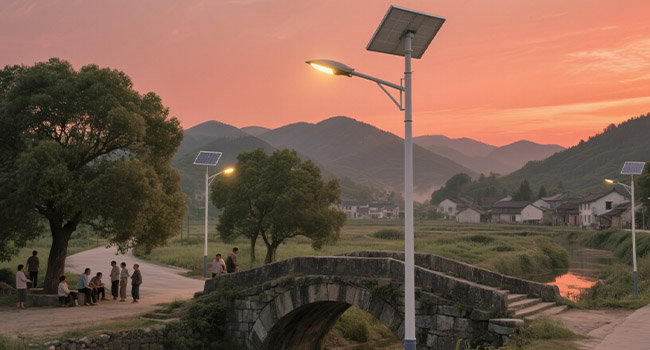
Enhance Economy
Power shortages have always been a huge obstacle to rural economic development. In the past, when night fell, the dark rural streets became cold and quiet, and stores and restaurants had to close early, making it difficult to sustain business activities. This not only seriously limits the rural consumer vitality, but also makes the rural economic development momentum. The emergence of solar street lights has brought a new turnaround for rural economic development. They provide stable and long-lasting lighting at night, which enables stores and restaurants to extend their business hours and directly increases the business income of merchants.
At the same time, a good night lighting environment also shows the potential of rural development to the outside world, attracting more investors, prompting more factories and enterprises to take root in the countryside, creating a large number of employment opportunities, and comprehensively activating the vitality of rural economic development.
Saves Environment
Solar street lights use solar energy as energy source, do not produce any harmful gases, and effectively improve the air quality in rural areas. At the same time, its reasonable lighting design to avoid light pollution, so that the rural night can still see the stars, guarding the natural beauty of the countryside, and contributing to ecological environmental protection.
The Application Scenarios of Solar Street Lights in Rural Areas
Lighting on Rural Roads
Rural roads often lack stable power supply, and traditional street lights have complicated wiring and high installation costs. Solar street lights rely on solar panels for power supply, do not need to be connected to the grid, and can be installed with simple fixing. Whether it's a narrow winding country road or a main road in a village carrying a lot of traffic, solar street lights can be easily adapted to the villagers' nighttime travel to build a solid safety line of defense, so that every road home is filled with warmth and light.
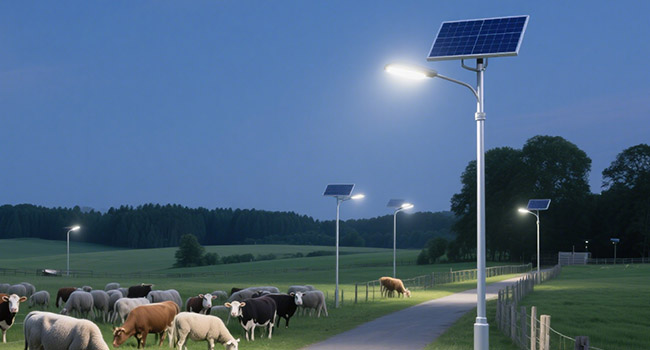
Lighting in Public Spaces and Squares
Rural squares, marketplaces, village committees and other public spaces are important places for villagers' communication and activities. Stable lighting from solar street lights makes night dancing in squares and night trading in bazaars the norm. Under the lights, villagers talk about their lives, shop for goods, and laugh constantly, effectively promoting the interaction of community members, so that the cohesion of the village continues to warm up in the light.
Farmland and Animal Farm Lighting
In some rural areas, lighting facilities need to be installed around farmland, fishponds and farms to ensure the safety of production activities at night. Solar led street lights can be flexibly adjusted to the installation position and height according to the size of the site, crop distribution and other actual needs, without additional wiring. In the darkness of the night, they continue to emit a soft light, providing a solid lighting support for agricultural production, aquaculture and other activities.
Lighting in Medical Facilities and Schools
Rural health centers and schools have an urgent need for stable lighting. Solar street lights bring bright light to school classrooms so that students can study and prepare for exams at night; provide sufficient lighting for emergency rooms, corridors and other areas of health centers to ensure that medical staff can clearly observe patients at night and ensure that emergency treatment is carried out efficiently and in an orderly manner, and help upgrade medical services in rural education.
Overcoming Challenges in Solar Street Lighting Installation
Logistical Challenges
In remote rural areas with poor infrastructure, the roads are rugged and narrow, and the transportation network is sparse, so it is a big problem to transport the materials of solar street lighting to the installation site. Some of the roads are even muddy and small, making it difficult for large transportation vehicles to pass through, and there is a lack of professional loading and unloading equipment. To solve this problem, solar street light manufacturers and installation teams need to plan transportation routes in advance, and choose suitable transportation tools such as minivans and tricycles for complicated road conditions.
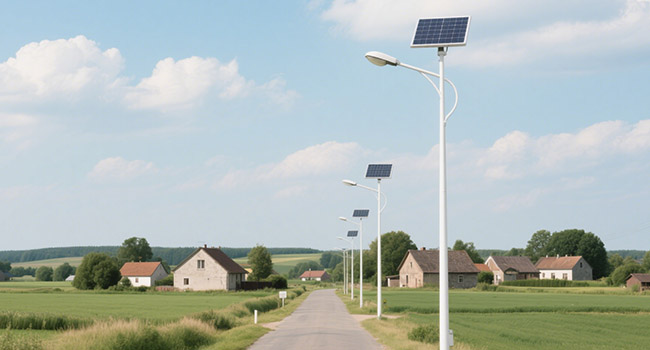
At the same time, they should cooperate with local logistics companies that are familiar with the local terrain, and make use of their rich transportation experience to ensure that the solar panels, lithium batteries and other installation resources are delivered on time and safely, so as to ensure that the installation work is carried out smoothly.
Technical Expertise
Due to the lack of professional technicians in rural areas, the installation and maintenance of new equipment such as solar street lights is difficult. Many villagers have little knowledge of electronic components and circuit connections, and even if they follow the instructions, they are prone to installation errors that affect the normal use of the street lights. In this regard, the training program can be carried out by inviting professional and technical personnel to give lectures to rural residents, using theoretical explanations combined with on-site practical exercises to teach in detail the installation steps, debugging points and simple maintenance knowledge of solar street lights. Through systematic training, a group of local technical personnel can be trained to deal with the common faults of the street lights in a timely manner, so as to ensure the long-term and stable operation of the street lights and reduce the subsequent maintenance costs.
Community Resistance
Some rural communities are skeptical about the new technology of solar street lights and are reluctant to accept it. Project leaders should actively communicate with community members, and through organizing seminars and distributing publicity materials, introduce in detail the advantages of solar street lights and how to use them, answer residents' questions, and eliminate their concerns, so as to win the community's support for the installation of solar street lights.
The application of LED solar street lights in rural areas brings not only light, but also all-round positive changes. From alleviating energy poverty and improving health, to promoting economic development and protecting the environment, to overcoming the challenges of the installation process, solar street lights have demonstrated strong vitality and broad application prospects. With the continuous progress of technology and increased promotion, we believe that solar street lights will take root in more rural areas, lighting the way forward for rural revitalization and sustainable development.


